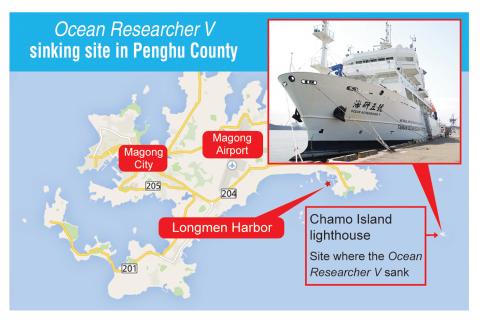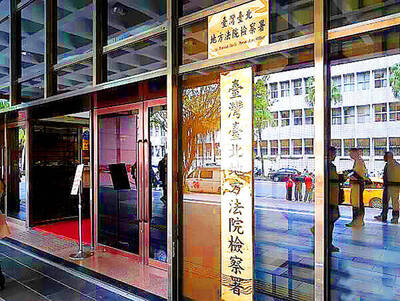An investigation has begun to determine why the Ocean Researcher V — the nation’s largest maritime research vessel — sank on Friday night near Penghu, leaving two people dead and 24 injured.
The 2,700-tonne vessel set sail from Greater Tainan at 9am on Thursday for an eight-day mission conducted by the Environmental Protection Administration (EPA) and National Taiwan Ocean University aimed at studying atmospheric pollution.
However, the two-year-old ship was completely submerged in stormy waters off Penghu’s Longmen District (龍門) by 8:11pm on Friday, less than three hours after it first issued a distress call, officials said.

Sea and air rescue efforts continued for several hours after that, ending with all 45 people on board — 27 researchers and an 18-member crew — all accounted for.
Academia Sinica research fellow and team leader Hsu Shih-chieh (許世傑) and Lin Yi-chun (林怡君), an assistant engineer at Taiwan Ocean Research Institute, died in the incident, with prosecutors saying that the two drowned during rescue efforts.
The 24 injured were sent to hospitals in Penghu and Chiayi and none of their injuries were said to be life-threatening.
Weng Ying-ming (翁英明), a division head at the EPA’s Environmental Analysis Laboratory, who had been in a cerebral hemorrhage-induced coma since being hospitalized, had regained consciousness yesterday morning and emerged from his critical condition, EPA Minister Wei Kuo-yen (魏國彥) said.
Minister of Science and Technology Simon Chang (張善政) told a press conference yesterday that the vessel set out from Tainan’s Anping Harbor (安平港) on Thursday morning after an assessment of sea conditions found it was safe to undertake the mission. However, at noon on Friday, the crew decided to return to port after an update from the Central Weather Bureau said that weather conditions had deteriorated and that the mission could be jeopardized.
Experts suspect that the ship hit a coral reef near Penghu before sinking, possibly after drifting from its planned route due to high waves and strong currents triggered by Typhoon Vongfong.
Survivors said they heard a banging sound before water began to flow into the vessel around 5pm.
According to 33-year-old researcher Hsu Chia-kuan (許家綸), the ship’s crew was gathering for dinner at about 5pm when the captain said over the intercom that the stern of the ship was leaking.
Hsu Chia-kuan quoted the captain as saying that he had sealed off the compartment, but asked that everyone put on their life vests. Hsu Chia-kuan added that the captain later ordered everyone to prepare to abandon ship.
Hsu Chia-kuan said he saw Hsu Shih-chieh directing people during the evacuation process, adding that it was sad that Hsu had not made it out with the others.
A video released by the Coast Guard Administration documenting the rescue mission showed the ship slanting, with the bow pointing up, before sliding into the sea, as passengers either jumped or were swept into the water.
Eight rescue helicopters, two C-130 transport planes, four navy frigates and five patrol boats were dispatched for the rescue mission, according to the Ministry of National Defense (MND) and coast guard yesterday.
Ministry spokesperson Major General David Lo (羅紹和) said calls came in from National Rescue Command Center at about 5:45pm on Friday requesting the rescue. Helicopters of the air force’s Air Rescue Group, based at central Taiwan’s Chiayi Air Base, went into action immediately at about 6pm.
According to a coast guard officer, the rescue ships got about 50m from the floundering vessel, but rough waves posed great difficulties.
“It was blowing strong northeasterly winds with high waves pounding at the ships. Although we got close to the research vessel, it was hard to maneuver and stay put [so] we just kept getting pushed backward,” the officer said. “The people waiting for rescue were crowded on the deck of the tilting vessel. Then after several big waves, that vessel began to list and began to sink quickly. We saw the people on deck being thrown into the sea and fortunately they all had life jackets on.”
The coast guard officer said some coast guard crews risked danger by taking off on small rafts to pick up survivors tossing about in the churning waves, while others were plucked out from the sea surface by rescue helicopter lifts.
National Applied Research Laboratories Vice President Chyi Jen-inn (綦振瀛), meanwhile, dismissed rumors that there had been Chinese crew members on board.
While local media outlets have raised questions about the competence of the crew, which is contracted out and rotated on a three-month basis — suggesting a possible lack of experience with the vessel — Chang dismissed rumors that research vessel Captain Huang Yu-fa (黃余發) lacked experience, saying Huang had been a freighter captain at Evergreen Marine Corp (長榮海運) before being enlisted by the ministry in March and has since piloted the ship several times.
Chang said Huang gained his status as a captain in 2003 and has at least 10 years of sailing experience, including experience with maneuvering vessels weighing more than 10,000 tonnes. However, after Evergreen Marine Corp later yesterday issued a statement denying that Huang had worked for the freight company, the ministry apologized for giving misleading information at the press conference.
Chang said the research ship cost NT$1.46 billion (US$47.95 million) to build and was insured for NT$1.5 billion. Chang added that details regarding compensation are being worked out and, for family members of the deceased, could amount to NT$10 million each.
While the Ministry of Transportation and Communications, the Ministry of Science and Technology and related agencies have been instructed by Premier Jiang Yi-huah (江宜樺) to participate in investigations and provide assistance to those in need, the Ministry of Transportation and Communications said its Marine and Port Bureau maritime assessment committee would conclude an investigation into the causes for the sinking within 15 days.
Marine and Port Bureau Director-General Chi Wen-jong (祁文中) said the vessel was carrying between 100 to 120 kiloliters, or about 100,000 to 120,000 liters of diesel fuel when it went down. The EPA has been instructed by the premier to continue monitoring for possible leaks and to have containment booms prepared.
Additional reporting by Huang Li-hsiang, Alison Hsiao and CNA

Intelligence agents have recorded 510,000 instances of “controversial information” being spread online by the Chinese Communist Party (CCP) so far this year, the National Security Bureau (NSB) said in a report yesterday, as it warned of artificial intelligence (AI) being employed to generate destabilizing misinformation. The bureau submitted a written report to the Legislative Yuan in preparation for National Security Bureau Director-General Tsai Ming-yen’s (蔡明彥) appearance before the Foreign Affairs and National Defense Committee today. The CCP has been using cognitive warfare to divide Taiwanese society by commenting on controversial issues such as Taiwan Semiconductor Manufacturing Co’s (TSMC, 台積電) investments in the

HELPING HAND: The steering committee of the National Stabilization Fund is expected to hold a meeting to discuss how and when to utilize the fund to help buffer the sell-off The TAIEX plunged 2,065.87 points, or 9.7 percent, to close at 19,232.35 yesterday, the highest single-day percentage loss on record, as investors braced for US President Donald Trump’s tariffs after an extended holiday weekend. Amid the pessimistic atmosphere, 945 listed companies led by large-cap stocks — including Taiwan Semiconductor Manufacturing Co (TSMC, 台積電), Hon Hai Precision Industry Co (鴻海精密) and Largan Precision Co (大立光) — fell by the daily maximum of 10 percent at the close, Taiwan Stock Exchange data showed. The number of listed companies ending limit-down set a new record, the exchange said. The TAIEX plunged by daily maxiumu in just

INVESTIGATION: The case is the latest instance of a DPP figure being implicated in an espionage network accused of allegedly leaking information to Chinese intelligence Democratic Progressive Party (DPP) member Ho Jen-chieh (何仁傑) was detained and held incommunicado yesterday on suspicion of spying for China during his tenure as assistant to then-minister of foreign affairs Joseph Wu (吳釗燮). The Taipei District Prosecutors’ Office said Ho was implicated during its investigation into alleged spying activities by former Presidential Office consultant Wu Shang-yu (吳尚雨). Prosecutors said there is reason to believe Ho breached the National Security Act (國家安全法) by leaking classified Ministry of Foreign Affairs information to Chinese intelligence. Following interrogation, prosecutors petitioned the Taipei District Court to detain Ho, citing concerns over potential collusion or tampering of evidence. The

‘COMPREHENSIVE PLAN’: Lin Chia-lung said that the government was ready to talk about a variety of issues, including investment in and purchases from the US The National Stabilization Fund (NSF) yesterday announced that it would step in to staunch stock market losses for the ninth time in the nation’s history. An NSF board meeting, originally scheduled for Monday next week, was moved to yesterday after stocks plummeted in the wake of US President Donald Trump’s announcement of 32 percent tariffs on Taiwan on Wednesday last week. Board members voted to support the stock market with the NT$500 billion (US$15.15 billion) fund, with injections of funds to begin as soon as today. The NSF in 2000 injected NT$120 billion to stabilize stocks, the most ever. The lowest amount it